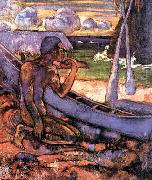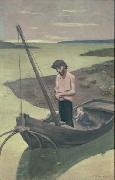
|
Paul Gauguin
|
|||
|
|
|||
| French 1848-1903 Paul Gauguin Art Locations (born June 7, 1848, Paris, France ?? died May 8, 1903, Atuona, Hiva Oa, Marquesas Islands, French Polynesia) French painter, sculptor, and printmaker. He spent his childhood in Lima (his mother was a Peruvian Creole). From c. 1872 to 1883 he was a successful stockbroker in Paris. He met Camille Pissarro about 1875, and he exhibited several times with the Impressionists. Disillusioned with bourgeois materialism, in 1886 he moved to Pont-Aven, Brittany, where he became the central figure of a group of artists known as the Pont-Aven school. Gauguin coined the term Synthetism to describe his style during this period, referring to the synthesis of his paintings formal elements with the idea or emotion they conveyed. Late in October 1888 Gauguin traveled to Arles, in the south of France, to stay with Vincent van Gogh. The style of the two men work from this period has been classified as Post-Impressionist because it shows an individual, personal development of Impressionism use of colour, brushstroke, and nontraditional subject matter. Increasingly focused on rejecting the materialism of contemporary culture in favour of a more spiritual, unfettered lifestyle, in 1891 he moved to Tahiti. His works became open protests against materialism. He was an influential innovator; Fauvism owed much to his use of colour, and he inspired Pablo Picasso and the development of Cubism. | |||
|
|
|||
|
Poor Fisherman Paul Gauguin27.jpg Painting ID:: 1356 |
|||
|
|
|||
|
Pierre Puvis de Chavannes
|
|||
|
|
|||
| 1824-1898 French Pierre Puvis de Chavannes Art Galleries Born in Lyons on Dec. 14, 1824, Pierre Puvis de Chavannes belonged to the generation of Gustave Courbet and ??douard Manet, and he was fully aware of their revolutionary achievements. Nevertheless, he was drawn to a more traditional and conservative style. From his first involvement with art, which began after a trip to Italy and which interrupted his intention to follow the engineering profession that his father practiced, Puvis pursued his career within the scope of academic classicism and the Salon. Even in this chosen arena, however, he was rejected, particularly during the 1850s. But he gradually won acceptance. By the 1880s he was an established figure in the Salons, and by the 1890s he was their acknowledged master. In both personal and artistic ways Puvis career was closely linked with the avant-grade. In the years of his growing public recognition, when he began to serve on Salon juries, he was consistently sympathetic to the work of younger, more radical artists. Later, as president of the Societe Nationale des Beaux-Arts - the new Salon, as it was called - he was able to exert even more of a liberalizing influence on the important annual exhibitions. Puvis sympathy to new and radical artistic directions was reflected in his own painting. Superficially he was a classicist, but his personal interpretation of that style was unconventional. His subject matter - religious themes, allegories, mythologies, and historical events - was clearly in keeping with the academic tradition. But his style eclipsed his outdated subjects: he characteristically worked with broad, simple compositions, and he resisted the dry photographic realism which had begun to typify academic painting about the end of the century. In addition, the space and figures in his paintings inclined toward flatness, calling attention to the surface on which the images were depicted. These qualities gave his work a modern, abstract look and distinguished it from the sterile tradition to which it might otherwise have been linked. Along with their modern, formal properties, Puvis paintings exhibited a serene and poetic range of feeling. His figures frequently seem to be wrapped in an aura of ritualistic mystery, as though they belong in a private world of dreams or visions. Yet these feelings invariably seem fresh and sincere. This combination of form and feeling deeply appealed to certain avant-garde artists of the 1880s and 1890s. Although Puvis claimed he was neither radical nor revolutionary, he was admired by the symbolist poets, writers, and painters - including Paul Gauguin and Maurice Denis - and he influenced the neoimpressionist painter Georges Seurat. During his mature career Puvis executed many mural paintings. In Paris he did the Life of St. Genevieve (1874-1878) in the Panth??on and Science, Art, and Letters (1880s) in the Sorbonne. In Lyons he executed the Sacred Grove, the Antique Vision, and Christian Inspiration (1880s) in the Mus??e des Beaux-Arts. He painted Pastoral Poetry (1895-1898) in the Boston Public Library. These commissions reflect the high esteem with which Puvis was regarded during his own lifetime. Among his most celebrated oil paintings are Hope (1872) and the Poor Fisherman (1881). He died in Paris on Oct. 10, 1898. | |||
|
|
|||
|
Poor fisherman new18/Pierre Puvis de Chavannes-532576.jpg Painting ID:: 50622 |
mk213 Oil on canvas | ||
|
|
|||
|
Pierre Puvis de Chavannes
|
|||
|
|
|||
| 1824-1898 French Pierre Puvis de Chavannes Art Galleries Born in Lyons on Dec. 14, 1824, Pierre Puvis de Chavannes belonged to the generation of Gustave Courbet and ??douard Manet, and he was fully aware of their revolutionary achievements. Nevertheless, he was drawn to a more traditional and conservative style. From his first involvement with art, which began after a trip to Italy and which interrupted his intention to follow the engineering profession that his father practiced, Puvis pursued his career within the scope of academic classicism and the Salon. Even in this chosen arena, however, he was rejected, particularly during the 1850s. But he gradually won acceptance. By the 1880s he was an established figure in the Salons, and by the 1890s he was their acknowledged master. In both personal and artistic ways Puvis career was closely linked with the avant-grade. In the years of his growing public recognition, when he began to serve on Salon juries, he was consistently sympathetic to the work of younger, more radical artists. Later, as president of the Societe Nationale des Beaux-Arts - the new Salon, as it was called - he was able to exert even more of a liberalizing influence on the important annual exhibitions. Puvis sympathy to new and radical artistic directions was reflected in his own painting. Superficially he was a classicist, but his personal interpretation of that style was unconventional. His subject matter - religious themes, allegories, mythologies, and historical events - was clearly in keeping with the academic tradition. But his style eclipsed his outdated subjects: he characteristically worked with broad, simple compositions, and he resisted the dry photographic realism which had begun to typify academic painting about the end of the century. In addition, the space and figures in his paintings inclined toward flatness, calling attention to the surface on which the images were depicted. These qualities gave his work a modern, abstract look and distinguished it from the sterile tradition to which it might otherwise have been linked. Along with their modern, formal properties, Puvis paintings exhibited a serene and poetic range of feeling. His figures frequently seem to be wrapped in an aura of ritualistic mystery, as though they belong in a private world of dreams or visions. Yet these feelings invariably seem fresh and sincere. This combination of form and feeling deeply appealed to certain avant-garde artists of the 1880s and 1890s. Although Puvis claimed he was neither radical nor revolutionary, he was admired by the symbolist poets, writers, and painters - including Paul Gauguin and Maurice Denis - and he influenced the neoimpressionist painter Georges Seurat. During his mature career Puvis executed many mural paintings. In Paris he did the Life of St. Genevieve (1874-1878) in the Panth??on and Science, Art, and Letters (1880s) in the Sorbonne. In Lyons he executed the Sacred Grove, the Antique Vision, and Christian Inspiration (1880s) in the Mus??e des Beaux-Arts. He painted Pastoral Poetry (1895-1898) in the Boston Public Library. These commissions reflect the high esteem with which Puvis was regarded during his own lifetime. Among his most celebrated oil paintings are Hope (1872) and the Poor Fisherman (1881). He died in Paris on Oct. 10, 1898. | |||
|
|
|||
|
Poor Fisherman new25/Pierre Puvis de Chavannes-344966.jpg Painting ID:: 92266 |
oil on canvas Dimensions 105.8 X 68.6 cm (41.7 X 27 in) cyf | ||
|
|
|||
|
Also Buy::. For Following Paintings / Artists / Products, Please Use Our Search Online: |










